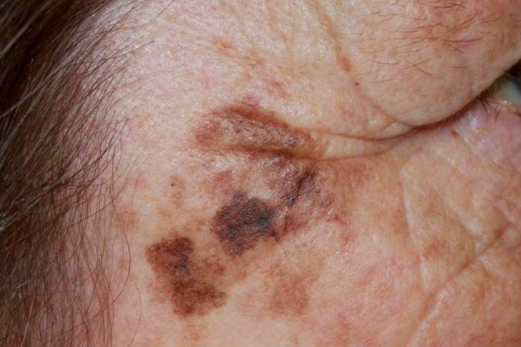Lentigo maligna is characterized by a distinctive, single, nonpalpable lesion with uneven brown-black pigmentation. It occurs on sun-exposed areas of the body, primarily the face, in elderly individuals and is considered a specific type of in situ melanoma arising from epidermal melanocytes. ICD-10 Code: D03.9
Published data indicate that lentigo maligna occurs in individuals over 40 years old, with a median age of onset 65 years. Blacks and Asians, including those from Southeast Asia, are rarely affected. The highest incidence is in fair-skinned individuals with skin types I, II, and III. The incidence increases with age, peaking in the seventh and eighth decades of life. Descriptive epidemiology suggests that the disease results from chronic cumulative sun exposure. Lesions typically appear on sun-exposed areas, primarily in individuals with fair skin.Lentigo maligna typically presents as a single lesion, a hyperpigmented spot, on sun-exposed areas of the skin, such as cheeks, nose, forehead, and ears. The brown-black color is accompanied by a well-defined irregular border. The surface is smooth, preserving the skin pattern but becoming rougher. Uneven pigmentation characterizes the lesion, with different parts showing brown, gray, bluish, or black tones in the peripheral pigmented area. The spot's size ranges from 2 to 6 cm, and with prolonged existence, it may reach 10 cm or more.
The lesion is usually solitary, infiltration within the pigmented zone is absent, but the skin is less elastic. Areas of depigmentation may be observed within the hyperpigmented areas, indicating regression. Lentigo maligna grows slowly over many years, often with minimal symptoms. Its diameter at diagnosis may range from 1 to several centimeters.- Seborrheic keratosis
- Solar lentigo
- Basal cell carcinoma
- Melasma
- Melanoma

